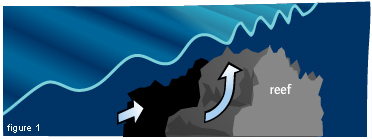The Canoe Is the People
Indigenous Navigation in the Pacific
Sea Marks

A wayfinder also relies on sea marks located in specific places to find the way. It might not be best to take the shortest path to an island if this means that you cannot check your course by seeing or feeling the sea marks. Wayfinders learn to use sea marks through experience as well as through stories and songs about them.
Reefs GLOSSARY reefs - areas of rock or coral below the surface of the water may act as sea marks, even those up to 50 m below the surface. The water above a reef has a different colour (light green) from the sea around it (blue). Short, steep waves sometimes form above a reef too. They are caused by a current GLOSSARY current - the directional flow of the sea meeting the reef. If the sea is flat, a navigator can see these waves from some kilometres away. At night, a wayfinder can feel the canoe move differently over them [See figure 1].
Sea life (like sharks, whales, and dolphins) also act as sea marks for a navigator. Extraordinary animals are often found at the same place along a path, even over centuries. Some are well known to navigators and have been given their own names. They can be as helpful as reefs in guiding the navigator. Some sea life can also be guides to show you where to find the land.
Knowledge about sea marks is closely protected. Student navigators chant GLOSSARY chant - sing, say lists of marks that they can look for between an island and each star point. A wayfinder’s family member may sing or tell a story about these sea marks while the wayfinder is at sea.
When we saw them, we knew we had permission to sail
Cook Islander Dorice Reid, crew member of Te Au o Tonga on the voyage to Taputapuatea Marae in 1995:
“We saw the birds, and we saw a whale. And we saw her go down and put her tail up, and she waved her tail just enough to allow us to know that she was there. And I say she because I’m sure the whale was a she. She waved her tail and disappeared. When we got to the mouth of the sacred harbour, the dolphins were there at the entrance. That meant we had permission to sail through that harbour. The priest of the marae said, ‘If you see the dolphins, that is your permission to go through the harbour.’ Well, they were there. ”






